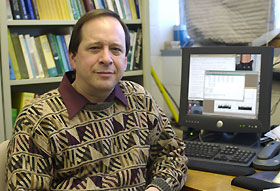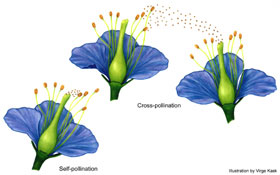|
This is an archived article.
For the latest news, go to the Advance Homepage
For more archives, go to the Advance Archive/Search Page. |
||
|
Biologist Explains Aspects Of Pollination
Birds, bees, and butterflies come to mind when the subject is how flowering plants are pollinated. But some plants pollinate themselves, and the majority are equipped to do so. Kent Holsinger, a professor of ecology and evolutionary biology, is trying to find out under which evolutionary circumstances self-pollination occurs and why.
His office has little by way of plant specimens or pictures. Instead, a computer occupies center stage. "Most of my work involves building mathematical models of conceptual issues," he says. Holsinger says the vast majority of flowering plants have male and female reproductive parts in the same flower, yet nearly 90 percent depend on pollinators to move pollen from one plant to another to make reproduction happen. Only a few self-pollinate. "People have been interested for a long time in why that might be the case," he says. The primary explanation, he says, is what biologists call "inbreeding depression," the phenomenon that inbred offspring are less vigorous, less fertile, and less likely to survive than those that are outbred. Yet Holsinger found that this phenomenon, although it generally prevents the evolution of self-fertilization, becomes less of a problem as self-fertilization begins to evolve. Predicting when self-fertilization may evolve is highly complicated, requiring detailed knowledge about the genetics of inbreeding depression in order to make reliable predictions about a particular plant, he says.
In the mid-1940's, says Holsinger, population geneticists suggested a different reason, connected with the way genes are transmitted in populations. In a population of out-breeding plants, each plant is both a male progenitor, via pollen, and a female progenitor, via ovules. A self-fertilizing plant in the same population that is by definition "mom" and "dad" to its own seeds also has the capacity to fertilize other plants with its pollen. Reproducing by three modes offers the plant a 50 percent advantage in begetting offspring, Holsinger says, but is not viable in the long term. There have been a number of transitions over evolutionary time from out-breeding to self-fertilization, but not the other way around, he says: "Selfing is an evolutionary dead end. It may be a successful strategy to allow a lineage to persist right now, but long-term, it appears it doesn't persist over millions of years." Holsinger's recent work on pollination systems has been trying to understand the circumstances under which self-fertilization has a transmission advantage and those under which it does not. To do so, he creates mathematical models that can predict the consequences of particular forces interacting with each other. Another way is to work back, describing the current status of a species and then constructing evolutionary scenarios for how that point was reached. The first stage, he says, is to obtain good statistics about the pattern of variation among individuals of a species in the same geographic area, or among individuals of a species in different geographic areas. He often collaborates with others who have developed this type of data. Unlike many of his departmental colleagues, who travel widely to gather information, most of Holsinger's research is conducted from his desk, taking the empirical work of others, identifying the underlying principles, and building mathematical or statistical models to explain them. He worked with colleague Janine Caira and one of her students, for example, to develop a quantitative measure of how closely parasites are associated with hosts. "I wouldn't have thought to investigate that type of question," he says. "The project involved both my facility with statistics and math and her insight into what really mattered in the organism. Neither one of us could have written it by ourselves." "In every area of science, many principles can be formulated as mathematical or statistical issues, and doing so may help clarify certain problems," he says. Holsinger is a former president of the American Genetic Association. He will be named a Fellow of the American Association for the Advancement of Science (AAAS) next week, for his contributions to understanding the evolution of plant reproductive systems. Holsinger joined the UConn faculty in 1986. He earned a Ph.D. in biology at Stanford University, and held postdoctoral positions at Stanford, Berkeley, and the University of California-Davis. He teaches population genetics, conservation biology, evolutionary biology, biological nomenclature, and the nature of scientific thought. He also takes his work to the public. A staunch proponent of evolutionary theory, in 2001 he wrote an opinion piece for The Hartford Courant debunking creationism, after a decision by the Kansas Board of Education to drop references to evolution from its school biology curriculum. Holsinger served on the Nature Conservancy Board in Connecticut for 10 years; has been on the advisory council of the New England Plant Conservation Program since the early 1990's; and has been on the board of the State Museum of Natural History since 1991, including a seven-year term as chair. He says his work with the Nature Conservancy gave him the opportunity to take basic principles and knowledge about ecology and evolution and apply them to actual problems. "It's a bit like tech transfer," he says. "Research is intellectually exciting, but it's also fun to figure out how science can affect people's lives." |

 One of the
early reasons identified for self-fertilization was
that circumstances might offer no other option. In
the absence of pollinators, either the plant
self-fertilizes and gets some seed, or it has no
seed and therefore no progeny. This phenomenon -
known as reproductive assurance - was first
identified by Darwin.
One of the
early reasons identified for self-fertilization was
that circumstances might offer no other option. In
the absence of pollinators, either the plant
self-fertilizes and gets some seed, or it has no
seed and therefore no progeny. This phenomenon -
known as reproductive assurance - was first
identified by Darwin.
